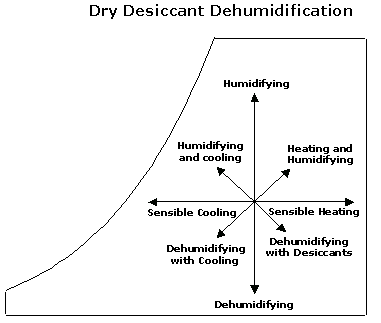Persons who want to control temperature and humidity of the air
in the air conditioning system should have an understanding of
psychrometry. They make use of psychrometric charts to determine
various parameters of the air at any condition. For example, by
knowing two parameters, you can look up the chart to find the
other values. The values found in a typical psychrometric chart
are:
| |
Dry Bulb Temperature |
| The dry-bulb temperature of air is measured
by a thermometer which is freely exposed to the air but is
shielded from radiation and moisture |
|
|
| Wet Bulb Temperature |
| The Wet-bulb Temperature of air is measured
by a thermometer whose bulb is covered by a muslin sleeve
which is kept moist with distilled and clean water, freely
exposed to the air and free from radiation |
| |
| Dewpoint Temperature |
| Dew point temperature is the temperature at
which moist air becomes saturated (100% relative humidity)
with water vapour when cooled at constant pressure, i.e. temperature
at which condensation of moisture begins when the moist air
is cooled. |
| |
| Relative Humidity |
| Humidity ratio or relative humidity is the ratio
of the actual mass of water vapor in the air to the mass of
water vapor that would saturate the air at the same temperature |
| |
| Enthalpy |
| The enthalpy of moist air is defined as the
sum of its internal energy and the product of its pressure
and volume. Specific enthalpy h (kJ/kg) of moist air is defined
as the total enthalpy of the dry air and water vapour mixture
per kg of moist air. |
| |
| Moisture Content |
| Specific humidity or moisture content of air
is the ratio of the mass of water to the mass of dry air in
a given volume of moist air |
| |
| Psychrometric processes, i.e.
any changes in the condition of the atmosphere, can be represented
by the movement of the state point on the psychrometric chart.
Common processes include: |
 |
Sensible cooling / sensible heating
|
| When an air-vapor mixture is heated or cooled,
without the addition or removal of moisture, the resulting
"process" may be plotted as a horizontal line on
the chart: |
| |
| Humidification / dehumidification
|
| Humidification can be made by spraying water
or steam to air.If humidification made by water, air will
move through wetbulb temperature line and dry bulb temperature
will decrease.If humidifaction made with steam air will move
through drybulb temp line and there will be no significant
change in drybulb temprature |
| |
| Cooling and dehumidification / heating and humidification |
| |
| |
| Evaporative cooling / chemical dehydration |
| |
| Sample
Psyhrometric Systems |

